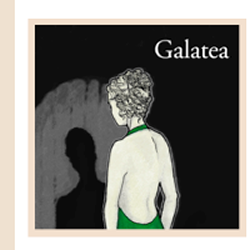

While Galatea is framed as an interactive fiction piece, the system shares many qualities with the long line of "chatterbots," going back to Joseph Weizenbaum's mid-1960s Eliza. Conversation with Galatea is not as free as with Eliza but can unfold in more interesting ways as the topic, Galatea's mood, and the history of conversation progress. The results of different discussions can sometimes even lead the user to uncover different stories that, while consistent within themselves, suggest different possible worlds.
To Begin ...
Mac: Download and install Spatterlight if you do not already have a z-machine interpreter. Download and unzip Galatea.zip and open the resulting file Galatea.z8 in your interpreter.
Windows: Download and install Gargoyle if you do not already have a z-machine interpreter. Download and unzip Galatea.zip and open the resulting file Galatea.z8 in your interpreter.
Author description: You come around a corner, away from the noise of the opening. There is only one exhibit. She stands in the spotlight, with her back to you: a sweep of pale hair on paler skin, a column of emerald silk that ends in a pool at her feet. She might be the model in a perfume ad; the trophy wife at a formal gathering; one of the guests at this very opening, standing on an empty pedestal in some ironic act of artistic deconstruction — You hesitate, about to turn away. Her hand balls into a fist. "They told me you were coming." An interactive conversation with Pygmalion's statue come to life, allowing the interactor to pursue different information or seek different relationships with the title character. Galatea won the 2000 IF Art Show and a XYZZY award for Best Non-Player Character.
Instructions: Type commands to the main character at the ">" prompt and press enter. Input can take the form of imperatives such as "look," "examine the pedestal," or "touch" followed by some object. The most important commands in Galatea are those that pertain to conversation, which include "ask about" followed by a topic (abbreviated to "a") and "tell about" a topic (abbreviated to "t"). These commands steer the subject of the conversation. The best approach is to follow up on a word or idea that Galatea has herself used, or to talk about objects present in the room. Other important verbs are "think about" followed by a topic to recall a previous topic, and "recap" to review the topics previously discussed.
Previous publication: The first version of Galatea was submitted by Short as part of the 2000 IF Art Show, in March 2000. Galatea was then revised and re-released to the IF Archive, at http://www.ifarchive.org, in August 2000. The revised Galatea is also available as a web-based Java version, http://jerz.setonhill.edu/if/gallery and http://nickm.com/if/emshort/galatea.html.
Short's work (the file Galetea.z8) is available under the Creative Commons Attribution-NonCommercial-NoDerivs 2.5 License. The Mac OS X Spatterlight interpreter is available under the GNU Public License. According to the readme file the Windows Gargoyle interpreter "is free software, and uses many components by various authors. The components are covered by their respective copyrights and licenses."